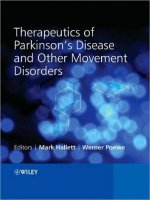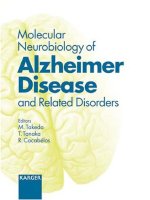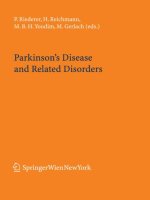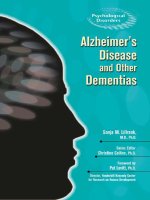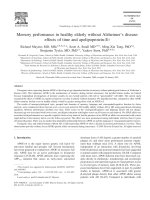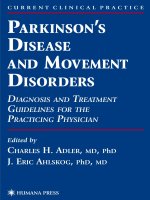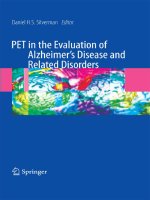ALZHEIMER’S DISEASE AND RELATED DISORDERS ANNUAL doc
Bạn đang xem bản rút gọn của tài liệu. Xem và tải ngay bản đầy đủ của tài liệu tại đây (1.45 MB, 226 trang )
5
ALZHEIMER’S
DISEASE AND
RELATED
DISORDERS
ANNUAL
00-Prelims (5) 8/31/05 11:00 AM Page i
00-Prelims (5) 8/31/05 11:00 AM Page ii
5
ALZHEIMER’S
DISEASE AND
RELATED
DISORDERS
ANNUAL
Edited by
Serge Gauthier, MD FRCPC
Professor and Director
Alzheimer’s Disease Research Unit
McGill Centre for Studies in Aging
Douglas Hospital
Verdun PQ
CANADA
Philip Scheltens, MD PhD
Department of Neurology / Alzheimer Center
Academisch Ziekenhuis
Vrije Universiteit
Amsterdam
The Netherlands
Jeffrey L Cummings, MD
Reed Neurological Research Center
University of California, Los Angeles
Los Angeles, CA
USA
00-Prelims (5) 8/31/05 11:00 AM Page iii
© 2006 Taylor & Francis, an imprint of the Taylor & Francis Group
First published in the United Kingdom in 2006 by Taylor & Francis, an imprint of the Taylor &
Francis Group, 2 Park Square, Milton Park, Abingdon, Oxon OX14 4RN
Tel.: +44 (0)20 7017 6000
Fax.: +44 (0)20 7017 6699
E-mail:
Website: www.tandf.co.uk/medicine
All rights reserved. No part of this publication may be reproduced, stored in a retrieval system, or
transmitted, in any form or by any means, electronic, mechanical, photocopying, recording, or
otherwise, without the prior permission of the publisher or in accordance with the provisions of
the Copyright, Designs and Patents Act 1988 or under the terms of any licence permitting limited
copying issued by the Copyright Licensing Agency, 90 Tottenham Court Road, London W1P 0LP.
Although every effort has been made to ensure that all owners of copyright material have been
acknowledged in this publication, we would be glad to acknowledge in subsequent reprints or
editions any omissions brought to our attention.
Although every effort has been made to ensure that drug doses and other information are present-
ed accurately in this publication, the ultimate responsibility rests with the prescribing physician.
Neither the publishers nor the authors can be held responsible for errors or for any consequences
arising from the use of information contained herein. For detailed prescribing information or
instructions on the use of any product or procedure discussed herein, please consult the prescrib-
ing information or instructional material issued by the manufacturer.
A CIP record for this book is available from the British Library.
Library of Congress Cataloging-in-Publication Data
Data available on application
ISBN 1 84184 561 2
978 1 84184 561 6
Distributed in North and South America by
Taylor & Francis
2000 NW Corporate Blvd
Boca Raton, FL 33431, USA
Within Continental USA Distributed in the rest of the world by
Tel: 800 272 7737; Thomson Publishing Services
Fax: 800 374 3401 Cheriton House
Outside Continental USA North Way
Tel: 561 994 0555; Andover, Hampshire SP10 5BE, UK
Fax: 561 361 6018 Tel: +44 (0)1264 332424
E-mail: E-mail:
Composition by Creative
Printed and bound in Great Britain by TJ International Ltd, Padstow, Cornwall
00-Prelims (5) 8/31/05 11:00 AM Page iv
List of Contributors vii
1.
Neuropathology of mild cognitive impairment 1
in the elderly
Steven T DeKosky, Milos D Ikonomovic, Ronald L Hamilton,
David A Bennett, and Elliot J Mufson
2.
Cerebrospinal fluid markers for the diagnosis 17
of Alzheimer’s disease
Niki Schoonenboom, Harald Hampel, Philip Scheltens,
and Mony de Leon
3.
Executive control function in ‘mild’ cognitive 35
impairment and Alzheimer’s disease
Donald R Royall
4.
Glycosaminoglycan mimetics in Alzheimer’s disease 63
Francine Gervais, Denis Garceau, Paul S Aisen, and
Serge Gauthier
5.
Immunotherapy for Alzheimer’s disease 73
David Wilkinson
6.
Cholesterol, copper, and statin therapy in 89
Alzheimer’s disease
D Larry Sparks, Suzana Petanceska, Marwan Sabbagh,
Donald Connor, Holly Soares, Charles Adler, Jean Lopez,
Nina Silverberg, Kathryn Davis, Suhair Stipho-Majeed,
Sherry Johnson-Traver, Paul Volodarsky, Chuck Ziolkowski,
Jeff Lochhead, and Patrick Browne
v
Contents
00-Prelims (5) 8/31/05 11:00 AM Page v
7.
Insulin resistance in Alzheimer’s disease – 111
a novel therapeutic target
Suzanne Craft, Mark A Reger, and Laura D Baker
8.
Atypical antipsychotics in dementia 135
Lesley M Blake and Jacobo Mintzer
9.
Treatment of vascular risk factors to delay 153
Alzheimer’s disease?
Frank-Erik de Leeuw, Raj Kalaria, and Philip Scheltens
10.
Cognitive dysfunction in multiple sclerosis 165
Julie A Bobholz and Angela Gleason
11.
Cholinesterase inhibitors in the treatment of 181
dementia associated with Parkinson’s disease
Murat Emre
12.
Modern applications of electroencephalography 191
in dementia diagnosis
CJ Stam
Index 207
00-Prelims (5) 8/31/05 11:00 AM Page vi
vii
Charles Adler PhD
Mayo Clinic
Scottsdale, AZ
USA
Paul S Aisen MD
Department of Neurology
Georgetown University Medical Center
Washington, DC
USA
Laura D Baker PhD
Assistant Professor of Psychiatry and
Behavioral Sciences, University of
Washington School of Medicine,
Geriatric Research, Education and
Clinical Center, Veterans Affairs Puget
Sound Health Care System
Seattle, WA
USA
David A Bennett MD
Rush Alzheimer’s Disease Center
Rush university Medical Center
Chicago, IL
USA
Lesley M Blake MD
Division of Geriatric Psychiatry
Northwestern University Medical
School
Chicago, IL
USA
Julie A Bobholz PhD
Assistant Professor of Neurology
Medical College of Wisconsin
Milwaukee, WI
USA
Patrick Browne MD
Center for Chest Disease
Division of Cardiology
Boswell Hospital
Sun City, AZ
USA
Donald Connor PhD
Cleo Roberts Clinical Research Center
Sun Health Research Institute
Sun City, AZ
USA
Suzanne Craft PhD
Professor of Psychiatry and Behavioral
Sciences
University of Washington School of
Medicine
Associate Director,
Geriatric Research, Education and
Clinical Center
Veterans Affairs Puget Sound Health
Care System
Seattle, WA
USA
Contributors
00-Prelims (5) 8/31/05 11:00 AM Page vii
Jeffrey L Cummings MD
Department of Neurology
David Geffen School of Medicine at
UCLA
Los Angeles, CA
USA
Kathryn Davis BA
Sun Health Research Institute
Sun City, AZ
USA
Steven T DeKosky MD
Department of Neurology
University of Pittsburgh School of
Medicine
Pittsburgh, PA
USA
FE De Leeuw MD PhD
Department of Neurology
University Medical Center St. Radboud
Nijmegen
The Netherlands
Mony de Leon PhD
New York University School of
Medicine
Center for Brain Health
New York, NY
USA
Murat Emre MD
Professor of Neurology
Head, Behavioral Neurology and
Movement Disorders Unit
Department of Neurology
Istanbul Faculty of Medicine
Çapa, Istanbul
Turkey
Denis Garceau PhD
Drug Development
Neurochem
Laval, Quebec
Canada
Serge Gauthier MD FRCPC
Professor and Director
Alzheimer’s Disease Research Unit
McGill Centre for Studies in Aging
Douglas Hospital
Verdun PQ
Canada
Francine Gervais PhD
Vice-President, R&D
Neurochem
Laval
Quebec
Canada
Angela Gleason PhD
Postdoctoral Fellow
Department of Neurology
Medical College of Wisconsin
Milwauke, WI
USA
Ronald L Hamilton MD
Division of Neuropathology
Department of Pathology
University of Pittsburgh School of
Medicine
Pittsburgh, PA
USA
Harald Hampel PhD
Department of Psychiatry
University of Munich
Nussbaumstr. 7
Munich
Germany
Milos D Ikonomovic MD
Alzheimer’s Disease Research Center
University of Pittsburgh School of
Medicine
Pittsburgh, PA
USA
viii
ALZHEIMER’S DISEASE AND RELATED DISORDERS ANNUAL
00-Prelims (5) 8/31/05 11:00 AM Page viii
Sherry Johnson-Traver
Sun Health Research Institute
Sun City, AZ
USA
Raj N Kalaria MD
Wolfson Research Centre
Institute for Ageing and Health
Newcastle General Hospital
Westgate Road
Newcastle upon Tyne
UK
Jeff Lochhead BS
Sun Health Research Institute
Sun City, AZ
USA
Jean Lopez RN MSN
Cleo Roberts Clinical Research Center
Sun Health Research Institute
Sun City, AZ
USA
Jacobo E Mintzer MD
Medical University of South Carolina
Charleston, SC
USA
Elliot J Mufson PhD
Division of Neuroscience
Rush University
Rush Presbyterian St Luke’s Medical
Center
Chicago, IL
USA
Suzana Petanceska PhD
Nathan Kline Institute and
Deptartments of Psychiatry and
Pharmmacology
New York University Medical Center
Orangeburg, NY
USA
Mark A Reger PhD
Acting Assistant Professor of Psychiatry
and Behavioral Sciences
University of Washington School of
Medicine
Geriatric Research, Education and
Clinical Center
Veterans Affairs Puget Sound Health
Care System
Seattle, WA
USA
Donald R Royall MD
Julia and Van Buren Parr Professor
for Alzheimer’s research in psychiatry
Chief: Geriatric Psychiatry Division
The University of Texas Health Sciences
Center at San Antonio
San Antonio, TX
USA
Marwan Sabbagh MD
Cleo Roberts Clinical Research Center
Sun Health Research Institute
Sun City, AZ
USA
Philip Scheltens MD PhD
Department of Neurology/Alzheimer
Center
VU University Medical Center
Amsterdam
The Netherlands
Niki Schoonenboom MD
Department of Neurology/Alzheimer
Center
VU University Medical Center
Amsterdam
The Netherlands
Nina Silverberg PhD
Sun Health Research Institute
Sun City, AZ
USA
CONTRIBUTORS
ix
00-Prelims (5) 8/31/05 11:00 AM Page ix
Holly Soares PhD
Pfizer Global R&D
Groton, CT
USA
D Larry Sparks PhD
Ralph and Muriel Roberts Laboratory
for Neurodegenerative Disease Research
and
The Cleo Roberts Center for Clinical
Research
Sun Health Research Institute
Sun City, AZ
USA
Cornelis J Stam MD PhD
Professor of Clinical Neurophysiology
Department of Clinical
Neurophysiology
VU University Medical Center
Amsterdam
The Netherlands
Suhair Stipho-Majeed MB ChB
CCRC
Sun Health Research Institute
Sun City, AZ
USA
Paul Volodarsky BS
Sun Health Research Institute
Sun City, AZ
USA
David Wilkinson MD
Consultant in Old Age Psychiatry and
Honorary Clinical Senior Lecturer
Memory Assessment and Research
Centre
Moorgreen Hospital
Botley Road
West End
Southampton
UK
Chuck Ziolkowski BS
Sun Health Research Institute
Sun City, AZ
USA
x
ALZHEIMER’S DISEASE AND RELATED DISORDERS ANNUAL
00-Prelims (5) 8/31/05 11:00 AM Page x
INTRODUCTION
The relationship of neuropathologic changes to the clinical status of people
with dementia is of paramount importance in devising appropriate therapeutic
interventions. Despite the fact that a central feature of the diagnostic criteria
for Alzheimer’s disease (AD) includes a history of insidious onset and a pro-
gression of cognitive decline, it was not until the mid 1990s, as large-scale
memory clinics obtained increased experience with people presenting early
with symptoms of mild dementia, that attention was directed at understanding
the processes occurring during the prodromal stages of dementia. Subse-
quently, individuals with mild memory loss, who were clinically followed
as their cognition deteriorated through stages of mild, moderate, and
severe AD, were neuropathologically confirmed postmortem as AD. These
neuropathologic findings, together with retrospective and prospective imaging
studies, led to a reexamination of our concepts of the neuropathologic changes
underlying the onset of early symptoms of cognitive impairment, as well as
the clinical definition of prodromal AD. Because it is believed that AD has an
extensive preclinical phase, it is important to identify people in an early stage
when brain pathology has been initiated but prior to significant clinical symp-
toms. During the past few years, the concept of mild cognitive impairment
(MCI) has developed as a possible prodromal stage of AD. Although the pre-
cise definition of MCI is being debated, recent evidence suggests that MCI falls
into several subtypes. Individuals with isolated memory loss, termed amnestic
mild cognitive impairment (aMCI), represent the most extensively analyzed
form of MCI in specialty clinics. The ‘conversion rate’ of aMCI people to AD
(the time at which they meet current formal criteria for AD) is 10–15% annu-
ally.
1
On the other hand, mild impairment defined by deficits in other cogni-
tive (and functional) domains is termed multiple domain MCI (mdMCI) and
may also occur as memory function declines below a defined threshold. In a
recent series of studies examining the onset of MCI in the Cardiovascular
Health Study (CHS) cohort, the risk factors for developing MCI included
apoE4 genotype (for aMCI), depression, racial and constitutional factors, and
1
1
Neuropathology of mild cognitive
impairment in the elderly
Steven T DeKosky, Milos D Ikonomovic, Ronald L Hamilton,
David A Bennett, and Elliot J Mufson
01-Chapter 1 5 8/31/05 11:04 AM Page 1
the presence of cerebrovascular disease.
2
In this population-based study, about
two-thirds of the MCI cases were mdMCI, and about one-third were aMCI.
3
Thus, a MCI is not as common in population-studies, and may be a less
frequent manner of progressing to AD. This chapter provides an overview of
neurobiologic observations crucial to our understanding of the chemical,
pathologic, and molecular changes which occur in brain during the transition-
al period between normal aging and the clinical diagnosis of all forms of MCI
and AD.
CLINICAL PRESENTATION OF MILD COGNITIVE
IMPAIRMENT
Clinical and neuropathologic data necessary for the investigation of MCI have
been derived from two types of cohorts. First are large clinic populations,
which have (small numbers of) subjects who come to autopsy while still clini-
cally classified as MCI. For example, the Alzheimer Disease Center at
Washington University, St Louis, have reported autopsy results from their
cohort of cases, some of whom died with a Clinical Dementia Rating (CDR) of
0.5, indicative of MCI.
4,5
A second source are volunteer cohorts of individuals
in a population study, such as the Nun Study
6
and the Religious Orders Study
(ROS),
7,8
in which all subjects agree to yearly cognitive and neurologic exami-
nation and brain autopsy at time of death. Because of their large size and
advanced age of their subjects, these cohorts enable the assessment of the
extent of pathologic and neurochemical changes in the brain associated with
cognitive changes in particular diagnostic categories, including normal cogni-
tion, MCI, and mild, moderate, and severe AD. In all of these cohorts MCI
marked a transitional state, with a decline of cognitive function that exceeded
the norms for the respective populations. However, the definitions of MCI
were somewhat different across cohorts. For example, a 0.5 CDR is used by
several groups as an indicator of MCI, whereas the ROS uses an actuarial deci-
sion tree that incorporates and can be overridden by clinical judgment, and
the Nun Study employs neuropsychologic testing patterns. Thus, the clinical
definition or diagnosis of MCI remains variable and perhaps controversial. In
this regard, Washington University utilized the CDR scale
9,10
to determine the
presence or absence of MCI (CDR 0.5) and referred to them either as very
mild AD or ‘early stage AD’.
11
Because the CDR 0.5 represents a global cogni-
tive score, these studies were careful in characterizing the specific cognitive
domains that can be affected in MCI subjects, segregating them further into
groups where cognitive impairment is uncertain (CDR 0.5/uncertain demen-
tia), or detected selectively in the memory domain (CDR 0.5), in memory and
up to two other domains (CDR 0.5/incipient dementia of the Alzheimer’s type,
DAT), or in memory and no less than 3 CDR domains (CDR 0.5/DAT).
11
Less
confident diagnosis of MCI was categorized as CDR 0/0.5, which proved not
to be distinct neuropathologically from CDR 0.5.
5,12
The CDR 0.5 cases are
2
ALZHEIMER’S DISEASE AND RELATED DISORDERS ANNUAL
01-Chapter 1 5 8/31/05 11:04 AM Page 2
comparable to MCI subjects from the ROS cohort or to ‘mild impairment –
memory impaired’ subjects from the Nun Study.
6
Clinical evaluation of the ROS population relied on a battery of tests that
included MMSE (Mini-Mental State Examination) as a measure of global cog-
nitive function,
13
seven tests of episodic memory, and 13 tests of other cogni-
tive abilities (for details of the cognitive function tests in ROS, see Wilson et
al
14
). Based on these tests, MCI subjects in the ROS were classified into aMCI
with impaired episodic memory and non-amnestic MCI without episodic
memory impairment.
15
In the Nun Study, MCI were defined as subjects with-
out dementia, who had preserved global cognition (measured by MMSE) and
normal daily activities, but who were impaired in either memory or another
cognitive domain.
6
However, the authors recognized that their MCI subjects
represented a mixed group of individuals impaired in multiple areas of cogni-
tion, or domains other than memory, whereas only a small proportion of them
were impaired in the isolated memory domain.
6
Similarly, many MCI cases in
the ROS studies are most likely also mdMCI, with impairment in one or more
cognitive areas.
Amyloid plaque pathology in MCI
The neuropathology of MCI is now being investigated in large-scale studies.
Studies from Washington University in St Louis have provided evidence that
virtually all subjects with a CDR score of 0.5 (approximately equivalent to
aMCI) displayed sufficient numbers of amyloid beta (Aβ) plaques and
neurofibrillary tangles (NFTs) to meet neuropathologic criteria for AD at
autopsy.
11
Using Khachaturian pathologic criteria,
16
only 1 in 8 of those cases
with no evidence of cognitive problems (CDR = 0 at entry and at death)
showed neuropathologic evidence of AD. While this suggests that many MCI
cases are preclinical AD, it did not define the extent of pathologic changes at
the time the person was first diagnosed with MCI. Recent clinical pathologic
investigations
17,18
provided evidence that 60% of MCI cases met the neu-
ropathologic diagnosis of AD according to CERAD
19
and NIA-Reagan
20
crite-
ria. Similarly, Petersen and colleagues reported that most of their MCI cases
postmortem displayed significant neuropathologic changes similar to AD.
1
Given that AD (and MCI) are being diagnosed earlier and earlier in the pro-
gression of dementia, perhaps it is time to rethink whether the amounts of
pathology needed to characterize a case as pathologic AD should be lower
than allowed by the current diagnostic standards.
Despite the fact that Aβ plaques symbolize one of the major neuropathologic
hallmarks of AD, their role in the initiation of AD dementia remains unclear.
Neuropathologic studies of cognitively normal elderly have found that some
already have considerable Aβ deposition in the brain.
5,21
More importantly,
virtually all patients with MCI have Aβ plaques.
5,22–24
Because Aβ deposition
is an early event in the course of AD, leading to other pathologies
(e.g. synapse loss, neuronal degeneration, and NFT formation) which corre-
late more closely with cognitive decline,
25,26
it becomes increasingly important
NEUROPATHOLOGY OF MCI IN THE ELDERLY
3
01-Chapter 1 5 8/31/05 11:04 AM Page 3
to define the extent of Aβ pathology during clinical changes from cognitively
intact to MCI to AD.
Postmortem analysis of subjects in the St Louis community cohort found
significant numbers of Aβ plaques in hippocampal and neocortical regions in
both CDR 0.5 and CDR 0/0.5 subjects.
27,28
The CDR 0.5 are not easily
distinguished from CDR 0/0.5 (questionable dementia), and were variably
considered as MCI or ‘early stage AD’ or ‘very mild dementia’.
11,27
The scarce
pathology in cognitively normal (CDR 0) individuals, reported in these and
other studies, indicates that brains of healthy aged people are, in general,
spared from Aβ pathology and should be discriminated from ‘pathologic
aging’.
29
The CDR 0.5 cases had substantial and widespread Aβ plaques in the
neocortex and to a lesser extent in the hippocampus, with a preponderance of
the diffuse type in the neocortex, and of neuritic types in the limbic regions
5
.
The pattern of Aβ plaque pathology across subjects with CDR 0 and CDR 0.5
led Price and colleagues to propose a continuum of Aβ plaque type that
changes during the conversion from normal (scarce diffuse plaques) to patho-
logic aging and MCI or ‘very mild dementia’ (many diffuse and neuritic
plaques).
12
The two clinical groups were different, based on densities of dif-
fuse and neuritic Aβ plaques in the entorhinal cortex (ERC) and temporal
neocortex,
22
supporting the theory that Aβ plaques may be of diagnostic value
in MCI.
4,30
The observations of extensive Aβ plaque pathology in MCI had been con-
firmed in other cohorts. The Baltimore Longitudinal Study of Aging
31
included
two subjects with questionable dementia (CDR 0.5) who had moderate neurit-
ic plaque frequencies, and were assigned neuropathologic diagnoses of proba-
ble AD. A clinical pathologic investigation of cases from the Jewish Home and
Hospital in New York revealed that, compared with subjects with CDR 0, the
CDR 0.5 subjects with questionable dementia had significantly increased den-
sities of neuritic plaques in frontal, temporal, and parietal cortex, but not in
occipital cortex, ERC, hippocampus, and amygdala.
23
These data further sug-
gest that an increase in neocortical Aβ pathology parallels the earliest sign of
cognitive decline in AD. An immunohistochemical study of Aβ load in the
ERC from ROS subjects clinically diagnosed as MCI, not cognitively impaired
(NCI), or mild to moderate AD found that the MCI cases were intermediate
between the other two groups, with wide overlap and no statistically signifi-
cant difference.
24
Aβ plaques were found in 83% of MCI, and the highest Aβ
load measured in this study was in an MCI case with a neuropathologic diag-
nosis of possible AD. The wide range of Aβ content in subjects with MCI, and
the considerable overlap with cognitively normal and demented subjects, fur-
ther supported the suggestion of MCI as a transitional stage from normal aging
to AD. Furthermore, this indicates that some MCI subjects resist deteriorating
into dementia despite a considerable amount of plaque pathology in their
mesial temporal lobe. Alternatively, it is possible that the addition of plaque
pathology in other brain regions is more relevant for the clinical manifestation
of dementia.
4
ALZHEIMER’S DISEASE AND RELATED DISORDERS ANNUAL
01-Chapter 1 5 8/31/05 11:04 AM Page 4
Biochemical measurements of Aβ
40
and Aβ
42
Neocortical tissue obtained postmortem from subjects selected from the
Jewish Home and Hospital in New York was examined for soluble and insolu-
ble Aβ
40
and Aβ
42
levels and revealed significant variability of total amyloid
levels across CDR groups.
32
Compared to normal (CDR 0) controls, the CDR
0.5 subjects (questionable dementia) showed elevated levels of both Aβ
species in the ERC, frontal, parietal, and visual cortex, similar to the
Washington University findings of increased Aβ plaques in their CDR 0.5
cases, although curiously not in the temporal lobe. Elevation of both Aβ
40
and
Aβ
42
levels correlated with the advancement of dementia. The authors con-
cluded that elevations in Aβ levels occurred very early in the disease progres-
sion, and this increase might influence the development of other types of AD
pathology.
In cerebrospinal fluid (CSF) samples and magnetic resonance imaging
(MRI) measurements taken from MCI and normal aged control subjects at
baseline and 1 year later, deLeon and colleagues combined ventricular volume
increases with measures of Aβ as well as phosphorylated tau (pTau231).
33
Cross-sectionally, Aβ
40
but not Aβ
42
was increased, as was pTau231. One year
later, the only significant change was an increase in pTau231, and that
was only if the ventricular enlargement (implying greater CSF volume) was
considered in the calculations.
Tau/neurofibrillary pathology in MCI
Unlike Aβ plaques, which may not be present in the brains of some of the very
elderly,
4
NFTs are an expected finding in all aged brains, although they may be
few in number and restricted to the ERC or hippocampus.
34–38
Considerable
amounts of pathologic tau (hyperphosphorylated tau aggregated into NFTs
and neuropil threads) have been reported in MCI. Price and colleagues
4,5
showed that ‘very mildly demented’/MCI cases (CDR 0/0.5 or 0.5) displayed
increased numbers of NFTs, particularly in the ERC and perirhinal cortex,
when compared with cognitively normal (CDR 0) controls. However, CDR 0
controls often display NFTs in the medial temporal structures. Whereas a sub-
group of these NFT-positive CDR 0 cases lacked Aβ deposits, in CDR 0.5 cases
NFTs were always accompanied by Aβ plaques, with the plaques being more
abundant in neocortical areas.
5
It was suggested that the initial NFT pathology
can occur without the presence of Aβ plaques; however, advanced NFT densi-
ties are most likely to occur following Aβ plaque formation.
5
In a review of
their cases, Morris and Price
30
noted that NFT distribution in these very mild
cases had not extended beyond the mesial temporal lobe, and suggested that
the presence of diffuse Aβ plaques in the cortex marked the onset of AD.
Examination of subjects from the Baltimore Longitudinal Study of Aging
found that CDR 0.5 cases manifested NFTs in the hippocampus and amygdala,
only scarce numbers of NFTs were seen in ERC or inferior parietal cortex,
NEUROPATHOLOGY OF MCI IN THE ELDERLY
5
01-Chapter 1 5 8/31/05 11:04 AM Page 5
whereas other neocortical regions lacked NFTs.
31
Similar findings were report-
ed for CDR 0 controls in this study, consistent with observations by Price and
colleagues.
5
These observations suggest that, unlike Aβ plaques, NFTs are less
likely to aid the distinction between normal aging and MCI. However, there is
a dramatic increase in entorhinal/hippocampal NFTs in the CDR 0.5 compared
to CDR 0.
28
Clinical pathologic investigations of subjects derived from the Jewish Home
and Hospital in New York revealed a significant positive correlation between
NFT densities and CDR scores.
37
However, NFT density in the CDR 0.5 sub-
jects with ‘questionable dementia’ was not different from CDR 0 controls; both
groups had NFTs in the ERC and hippocampus. This study suggested that
NFT pathology increased with progression of dementia severity, but it was not
a reliable pathologic marker to distinguish MCI. Similarly, a study of
“oldest-old” subjects autopsied in the Geriatric Hospital of the University of
Geneva in Switzerland showed that Braak neuropathologic staging
39
correlated
highly with clinical CDR scores. However, it was difficult to distinguish
between CDR 0 and CDR 0.5 groups in this cohort.
38
In the ROS population, the status of tau pathology was examined in MCI
(MMSE 26.8 ± 2, not different from controls), mild to moderate AD, and aged
control cases.
40
This study reported correlation of granulovacuolar and fibril-
lar lesions with several measures of episodic memory. Neuropil threads (NT)
preceded the appearance of NFT, which in turn appeared prior to neuritic Aβ
plaques. There were no statistically significant correlations between tau
pathology measurements and clinical classifications of NCI, MCI, and AD. A
quantitative stereologic investigation of phosphorylated tau pathology in the
parahippocampal gyrus from MCI, NCI, and AD subjects from the ROS cohort
demonstrated that MCI (MMSE 25.8 ± 2.9, not different from NCI) had a non-
significant increase in both NFT and NT densities compared to NCI.
41
In
contrast, the AD subjects showed significantly increased NFTs compared to
controls, but not MCI, and were comparable to controls with respect to NT
pathology.
41
Increasing NFT (but not NT) pathology correlated with impaired
performance on a measurement of episodic memory, suggesting that NFT
pathology plays a role in the clinical progression from NCI to MCI, and fur-
ther into AD. DeKosky and colleagues examined the relationship between the
extent of neuropathologic changes by NIA/Reagan criteria
18
or Braak stage
42
and choline acetyltransferase (ChAT) activity levels in ROS subjects. Almost
half of the MCI group had intermediate likelihood (NIA/Reagan category) of
AD, with another 11% having high likelihood;
18
53% of persons with MCI
were Braak stage III/IV and 18% were Braak stage V/VI.
42
These observations
of significant AD pathology in MCI were confirmed in an enlarged cohort of
MCI subjects from the same ROS cohort.
8
Further support for the hypothesis that NFT pathology influences MCI is
derived from a clinical pathologic evaluation of brain tissue harvested from the
Nun Study. This study reported a strong correlation between the progression
of NFT pathology, as defined by Braak staging, and cognitive impairment,
6
ALZHEIMER’S DISEASE AND RELATED DISORDERS ANNUAL
01-Chapter 1 5 8/31/05 11:04 AM Page 6
especially in the younger age groups.
6
About half of MCI subjects (with intact
or impaired memory) were Braak stage I/II. This investigation pointed out the
variability of neuropathologic findings in mildly impaired people with or with-
out memory problems, at different stages of cognitive impairment at time of
death. After separating their MCI cases into a group with significant memory
impairment and those without much memory impairment, it was found that
23% of the non-memory impaired had Braak scores of 0 (no entorhinal NFTs).
On the other hand, in the memory impaired group, which is most comparable
to MCI in the literature, no cases lacked NFTs in the entorhinal/transento-
rhinal area.
An investigation of participants in a longitudinal study at the University of
Miami found that MCI patients (diagnosed as a selective impairment of mem-
ory function) showed considerably greater density of NFTs in the fusiform
gyrus and medial temporal areas compared with non-demented controls, while
Aβ plaques were variable.
43
Additional studies of the quantitative changes in
tau pathology are needed to clarify whether this or other types of pathology
play a role in the clinical symptoms of MCI. Definition of MCI needs to be
carefully characterized in all such studies.
Neuronal cell pathology in MCI
Several studies have examined changes in neuronal numbers in MCI, focusing
either on the mesial temporal cortex or the cholinergic basal forebrain nuclei
(CBFN). The ERC, the major paralimbic cortical relay region for the transmis-
sion of cortical information to the hippocampus, was of interest because it
undergoes neurodegenerative changes in the earliest stages of disease progres-
sion.
28,39,44–47
Cases from the Washington University cohort showed no signif-
icant decrease in numbers of Nissl-stained neurons or ERC volume with age
in healthy non-demented individuals. Few or no differences were observed
between the healthy controls and what was termed ‘preclinical AD’, or cases
with normal cognition (CDR 0) but a good deal of accumulated plaques and
tangles at autopsy.
12
However, neuronal numbers were significantly decreased
in the ERC (35%; 50% of cells in lamina II) and hippocampal CA1 (46% loss)
in very mild AD (CDR 0/0.5 or CDR 0.5); cell loss was even more profound in
severe AD. These findings suggest that cell atrophy and death have already
occurred at a time when patients begin to manifest clinical symptoms of AD.
The results of these studies are consistent with a previous report by Gomez-
Isla and colleagues using cases from Washington University, which showed
similar neuronal loss in the ERC (32%; 57% in lamina II).
28
Unbiased quanti-
tative stereology revealed significant loss of NeuN-immunoreactive neurons in
the ERC lamina II of MCI (63%) and mild to moderate AD (58%) in cases
derived from the ROS cohort.
47
Moreover, there was also a reduction in lamina
II ERC volume in MCI (26%) and AD (43%), in agreement with previous find-
ings.
12
ERC atrophy correlated with impairment on MMSE and clinical tests of
declarative memory.
30,47
NEUROPATHOLOGY OF MCI IN THE ELDERLY
7
01-Chapter 1 5 8/31/05 11:04 AM Page 7
Cholinergic basal forebrain system dysfunction
The cholinotrophic phenotype of the CBFN neurons is altered during the pro-
dromal and earliest stages of AD. Quantitative stereologic studies revealed that
the number of nucleus basalis (NB) perikarya expressing either ChAT, the syn-
thetic enzyme for acetylcholine, or the vesicular acetylcholine transporter
(VAChT) was stable in MCI and mild AD.
48
Moreover, other studies demon-
strated that ChAT activity in NB cortical projection sites is unchanged in mild
AD.
17,18
Taken together, these observations suggest that the enzymes underly-
ing basocortical cholinergic neurotransmission are preserved in MCI and early
AD, although cholinergic function is probably impaired as these neurons con-
tain NFTs.
49
The number of NB perikarya expressing either the high-affinity
nerve growth factor (NGF)-selective receptor trkA or the pan-neurotrophin
receptor p75
NTR
was reduced ~50% in MCI and mild AD compared with NCI,
and this deficit correlated significantly with impaired performance on the
MMSE and a few individual tests of working memory and attention.
50,51
Many
cholinergic NB neurons appear to undergo a phenotypic silencing of NGF
receptor expression in the absence of frank neuronal loss during the early
stages of cognitive decline, as trkA (but not p75
NTR
mRNA) was reduced in
NB neurons in MCI and AD
52
as well as in the cortex.
53
These alterations may
signify an early deficit in neurotrophic support during the progression of AD:
perhaps this related to the early declines in cholinergic function and the
sensitivity of the cholinergic system to cholinergic blockers.
54
NGF levels are preserved in the hippocampus and neocortex in MCI sub-
jects.
55
ProNGF (the precursor molecule for NGF) is elevated 1.4 times above
controls in the parietal cortex in MCI, and 1.6 times above control levels in
mild AD.
56
Thus, the perturbations in NGF signaling within the cholinotroph-
ic basal forebrain system in early AD may be initiated by defective NGF retro-
grade transport due to reduced receptor protein levels in cortical projection
sites, which ultimately affects NB neuronal survival, or due to alteration in the
ratio of cortical proNGF to trkA.
53
The presence of cell cycle proteins within
NB neurons in MCI and mild AD cases from the ROS cohort
57
suggests that
cortical NGF receptor imbalance may contribute to the selective vulnerability
of cholinergic NB neurons via deficits in trkA-mediated pro-survival signaling
and/or alterations in p75
NTR
-mediated signaling, which promotes unscheduled
cell cycle re-entry and apoptosis during the prodromal stages of AD.
Collectively, these data support the concept that MCI is associated with phe-
notypic changes (e.g. trkA, p75
NTR
), but not frank neuronal degeneration, in
the CBFN. Factors other than these particular markers of cholinergic neurons,
or dysfunction of other cell populations (e.g. ERC lamina II neurons), also
play a role in the differences in cognitive function.
Cholinergic enzyme changes in MCI
ChAT loss has been regarded as the hallmark neurotransmitter change in AD.
Most investigators have always presumed that loss of cholinergic function
8
ALZHEIMER’S DISEASE AND RELATED DISORDERS ANNUAL
01-Chapter 1 5 8/31/05 11:04 AM Page 8
underlies much of the short-term memory loss in AD, and probably in MCI as
well. The observations that physostigmine and oral anticholinesterases have
beneficial effects for patients with AD suggest that the cholinergic basal fore-
brain system is altered despite the absence of ChAT enzyme deficits in AD. In
fact, a series of studies have shown that neocortical ChAT activity is preserved
in MCI.
17,18,58,59
Thus, cholinergic enzyme deficits are probably not the pri-
mary cause of the memory loss in MCI, although these studies do not rule out
other types of cholinergic dysfunction early in the disease course. On the
other hand, DeKosky and colleagues found elevated ChAT activity in the hip-
pocampus and frontal cortex of subjects with MCI.
18
These results suggested
that cognitive deficits in MCI and early AD are not associated with ChAT
reduction in the hippocampus, and that select components of the hippocam-
pal and cortical cholinergic projection system are capable of compensatory
responses during the early stages of dementia. Increased hippocampal and
frontal cortex ChAT activity in MCI may be important in promoting biochemi-
cal stability, or compensating for neurodegenerative defects, which may delay
the transition of these subjects to AD. Interestingly, hippocampal ChAT activi-
ty was increased selectively in those MCI cases scored as a Braak III/IV stage,
suggesting that a compensatory up-regulation of ChAT occurs during the pro-
gression of entorhinal–hippocampal NFT pathology.
42
This cholinergic up-
regulation is reminiscent of the cholinergic axonal plasticity response in the
hippocampus following denervation or loss of excitatory input from the ERC
lamina II neurons observed in animal models of AD
60
as well as in AD
brains.
61,62
This neuronal reorganization may account for the increase in ChAT
activity observed in the MCI hippocampus, considering the fact that NFT
changes involved most of the ERC lamina II neurons by the time these
subjects developed MCI.
18,42
The reasons for the elevation of ChAT in frontal
cortex in MCI is less clear, but is most probably also the result of cholinergic
sprouting.
Acetylcholinesterase (AChE), the enzyme that hydrolyzes acetylcholine at
the synapse, did not show decline in cortical areas until at least moderately
severe levels of dementia were present.
17
Positron emission tomography (PET)
studies, utilizing a ligand that labels AChE in vivo, suggested that there is only
mild loss of AChE in MCI
63
and mild AD.
64
Notably, in the latter study the
loss in AD was less than that in Parkinson’s disease or Parkinson’s dementia.
The manner in which this cholinergic enzyme impacts cognitive decline in AD
remains an area of great interest. Studies utilizing AChE PET ligands in large
sample sizes can be expected to be undertaken in the future.
Other neurochemical markers
Levels of isoprostane, 8,12-iso-iPF2alpha-VI, a sensitive marker for in-vivo
lipid peroxidation (and thus of degree of oxidative stress), are elevated in
urine, blood, and CSF in AD, and correlate with cognitive and functional
scores as well as CSF tau and amyloid concentrations.
65
To the extent that the
MCI cases had an intermediate level of the isoprostane, this study may
NEUROPATHOLOGY OF MCI IN THE ELDERLY
9
01-Chapter 1 5 8/31/05 11:04 AM Page 9
indicate the degree of oxidative stress in the pathologic processes in MCI
brains. If confirmed, this method might have promise for diagnosis and as a
biomarker for the level of oxidative stress in AD.
Soluble alpha-synuclein (α-syn), a heat-stable protein that plays an impor-
tant role in neuronal plasticity, was significantly reduced in the frontal cortex
in AD patients compared with MCI and NCI patients from the ROS cohort;
there were no differences between MCI and NCI.
66
The immunoreactivity of
α-syn correlated with MMSE score and a global neuropsychologic z-score.
Similar results were found in a study examining the relation of Lewy bodies
identified with α-syn antibodies in the substantia nigra, limbic system, and
several neocortical regions in cases from the ROS.
8
About 10% of patients with
MCI and those without cognitive impairment had Lewy bodies; by contrast,
more than 20% of patients with dementia had Lewy bodies.
Both MCI and AD groups had markedly elevated expression of heme oxyge-
nase-1 (HO-1, an indirect marker of oxidative stress) in the hippocampus and
temporal neocortex.
67
Astroglial HO-1 immunoreactivity in the temporal cor-
tex, but not hippocampus, correlated with the burden of neurofibrillary
pathology. These data strengthen earlier observations suggesting that oxidative
stress may be a very early event in the pathogenesis of AD.
Synapse counts in MCI
Evaluation of synapse numbers in biopsy-derived
68
and postmortem
69
tissue
show a high correlation with cognitive impairment. Although there are no
published studies on the status of synaptic integrity in MCI, a preliminary
stereologic analysis of synapse counts in the hippocampus from ROS cases
showed remarkable variability.
70
In MCI, the number of synapses in two
regions of the hippocampus (CA1 and outer molecular layer of dentate gyrus)
was reduced on average, and the synaptic densities seemed to fall either in the
AD range or in the range of the controls. More cases will be needed to deter-
mine the precise nature of synapse loss in different regions of brain during the
progression of AD.
Subcortical (white matter) changes and cerebrovascular
disease
Subcortical white matter alterations and loss (subcortical atrophy leading to
hydrocephalus ex vacuo) are well-known correlates of AD. Thus, age-related
white matter changes, such as ubiquitin-immunoreactive granular degenera-
tion of myelin, may occur during the progression of AD and contribute to
cognitive (and motor) dysfunction. In an immunohistochemical study of ubiq-
uitin and myelin basic protein (MBP) in frontal white matter of subjects from
the ROS cohort, MBP was significantly decreased (28%) in mild AD but not in
MCI compared with control brain white matter samples.
71
MBP changes corre-
lated with both global and frontal function-specific tests of cognition, suggest-
10
ALZHEIMER’S DISEASE AND RELATED DISORDERS ANNUAL
01-Chapter 1 5 8/31/05 11:04 AM Page 10
ing that white matter pathology may contribute to age- and disease-associated
cognitive decline.
An examination of the relationship of macroscopic cerebral infarctions to
MCI in ROS demonstrated that one-third of MCI cases had cerebral infarc-
tions.
8
This was in contrast to nearly 50% of patients with dementia and less
than 25% of patients without cognitive impairment.
CONCLUSIONS
Neuropathologic and neurochemical studies are emerging to aid in the defini-
tion of the brain’s status during the earliest stages of symptomatic cognitive
impairment as well as presymptomatic AD. Initial conclusions suggest that
significant Aβ deposition, NFT formation, and neuronal cell loss (especially in
the mesial temporal lobe), and alterations in the NGF neurotrophin receptor
system, are evident, but without major differences between cases with a clini-
cal diagnosis of MCI at death and those clinically diagnosed as ‘mild’ AD.
Other significant markers, or system disruptions, are yet to be identified. In
addition, the synaptic and cholinergic plasticity, which may differ from indi-
vidual to individual, no doubt contribute to the variability of the pathologic
findings. Based upon the multiple markers thus far explored, variability in the
MCI cases is going to be multidimensional, and there is no indication that one
specific pathologic or biochemical variable will be an absolute quantitative
marker of MCI.
It does not appear possible to predict accurately the extent/severity of neuro-
pathologic changes based only on the cognitive status of an individual. In cog-
nitively normal cases with only small numbers of NFTs in the ERC and few or
no Aβ deposits anywhere, one cannot accept these as being AD or even incipi-
ent AD. However, we can, to some degree, feel confident that nearly all cases
with some cognitive impairment (even MCI) will show pathologic changes
with varying degrees of NFTs and Aβ plaques. MCI cases have a range of AD
pathology that includes NFTs in the ERC and Aβ deposits in the neocortex,
and show considerable overlap with the pathology found in ‘early AD’ to such
an extent that it is still impossible in a given case to accurately predict the
severity of clinical impairment based on the neuropathologic changes when
they are in low Braak stages (≤stage III) and contain less than a moderate
number of neuritic plaques in the neocortex.
There are several possible reasons for inconsistencies in the literature
describing the neuropathology of MCI, including insufficient sample size,
neuropathologic heterogeneity within and across diagnostic groups, selection
of the measure of pathologic changes, lack of a unified clinical definition of
MCI, and the possibility that the cognitive status at the time of death may
have progressed from the one that was determined during the last neuropsy-
chologic testing which served to establish the ‘final’ clinical diagnosis of MCI.
Thus, the antemortem interval from the last clinical diagnosis to death needs
NEUROPATHOLOGY OF MCI IN THE ELDERLY
11
01-Chapter 1 5 8/31/05 11:04 AM Page 11
to be as short as possible. In most of the studies presented in this chapter, the
last clinical evaluation was performed within 1 year of death. A unified clinical
diagnostic and neuropathologic testing procedure, which would serve for
more consistent correlative investigations of cognitive status vs neuropatho-
logic changes, would also be of immense benefit for MCI research. For a vari-
ety of logistical reasons, that is not likely to happen. However, agreement
among groups which use different approaches would be powerful. The neu-
ropathologic distinction between MCI and cognitively normal aged people, or
those with early dementia, has also been difficult because a wide range of neuro-
pathologic changes were present in each of these clinical diagnostic groups,
with significant overlap. Brains of cognitively normal people often contain
substantial amounts of neuropathologic changes, including Aβ plaques and
NFTs,
24,72,73
similar to what is seen in MCI. Studies relying on quantitative
biochemical measurements or direct (stereological) counting of neuropatho-
logic changes might be of help in improving the clinical/pathologic correlates.
The search for the status of the brain in MCI will continue with postmortem
analyses as well as in-vivo studies. Recent results indicate that Aβ imaging in
vivo can be accomplished in AD.
74
Preliminary data on cases with MCI sug-
gest that, like the synapse data, the means of Aβ load are midway between AD
cases and controls, but that the individual cases lie either in the range of nor-
mals or in the range of AD cases. On the other hand, recent MRI studies indi-
cate that MCI have reduced ERC and hippocampal volume
75,76
and higher rate
of hippocampal volume loss.
77
It is unlikely that a single marker, neuropatho-
logic or clinical, will emerge as a standard measure of MCI-specific pathology.
However, since there is great neuropathology overlap between MCI and AD,
the current data suggest that MCI is a prodromal form of AD.
ACKNOWLEDGMENTS
This work was supported by the NIA grants AG05133, AG14449, AG16668,
AG09446 and AG10161.
REFERENCES
12
ALZHEIMER’S DISEASE AND RELATED DISORDERS ANNUAL
1. Petersen R. Mild Cognitive
Impairment: Aging to Alzheimer’s
Disease. New York: Oxford
University Press, 2003.
2. Lopez OL, Jagust WJ, Dulberg C,
et al. Risk factors for mild cognitive
impairment in the Cardiovascular
Health Study Cognition Study: part 2.
Arch Neurol 2003;60:1394–1399.
3. Lopez OL, Jagust WJ, DeKosky ST,
et al. Prevalence and classification
of mild cognitive impairment in
the Cardiovascular Health Study
Cognition Study: part 1. Arch Neurol
2003;60:1385–1389.
4. Price JL, Davis PD, Morris JC, et al.
The distribution of tangles, plaques
and related immunohistochemical
01-Chapter 1 5 8/31/05 11:04 AM Page 12
markers in healthy aging and
Alzheimer’s disease. Neurobiol Aging
1991;12:295–312.
5. Price JL, Morris JC. Tangles and
plaques in nondemented aging and
“preclinical” Alzheimer’s disease.
Ann Neurol 1999;45:358–368.
6. Riley KP, Snowdon DA, Markesbery
WR. Alzheimer’s neurofibrillary
pathology and the spectrum of
cognitive function: findings from the
Nun Study. Ann Neurol 2002;
51:567–577.
7. Bennett DA, Wilson RS, Schneider
JA, et al. Natural history of mild cog-
nitive impairment in older persons.
Neurology 2002;59:198–205.
8. Bennett DA, Schneider JA, Bienias JL,
et al. Mild cognitive impairment is
related to Alzheimer disease patholo-
gy and cerebral infarctions. Neurology
2005;64:834–841.
9. Hughes CP. A new clinical scale for
staging of dementia. Br J Psychiatry
1982;140:566–572.
10. Morris JC. The Clinical Dementia
Rating (CDR): current version and
scoring rules. Neurology 1993;43:
2412–2413.
11. Morris JC, Storandt M, Miller JP,
et al. Mild cognitive impairment
represents early-stage Alzheimer
disease. Arch Neurol 2001;58:
397–405.
12. Price JL, Ko AI, Wade MJ, et al.
Neuron number in the entorhinal
cortex and CA1 in preclinical
Alzheimer’s disease. Arch Neurol
2001;58:1395–1402.
13. Folstein MF, Folstein SE, McHugh
PR. “Mini-mental state”. A practical
method grading the cognitive state of
patients for the clinician. J Psychiatry
Res 1975;12:189–198.
14. Wilson RS, Beckett LA, Barnes LL, et
al. Individual differences in rates of
change in cognitive abilities of older
persons. Psychol Aging 2002;17:
179–193.
15. Aggarwal NT, Wilson RS, Beck TL, et
al. The apolipoprotein E epsilon-4
allele and incident Alzheimer’s dis-
ease in person’s with mild cognitive
impairment. Neurocase 2005;11:3–7.
16. Khachaturian ZS. Diagnosis of
Alzheimer’s disease. Arch Neurol
1985;42:1097–1105.
17. Davis KL, Mohs RC, Marin D, et al.
Cholinergic markers in elderly
patients with early signs of
Alzheimer’s disease. JAMA 1999;
281:1401–1406.
18. DeKosky ST, Ikonomovic MD, Styren
S, et al. Upregulation of choline
acetyltransferase activity in hippo-
campus and frontal cortex of elderly
subjects with mild cognitive impair-
ment. Ann Neurol 2002;51:
145–155.
19. Mirra SS, Heyman A, McKeel D, et al.
The Consortium to Establish a
Registry for Alzheimer’s Disease
(CERAD). Part II. Standardization of
the neuropathologic assessment of
Alzheimer’s disease. Neurology 1991;
41:479–486.
20. National Institute on Aging and
Reagan Institute working group on
diagnosis criteria for the neuropatho-
logical assessment of Alzheimer’s dis-
ease. Consensus recommendations
for the postmortem diagnosis of AD.
Neurobiol Aging 1997;18:S1–S3.
21. Braak H, Braak E. Frequency of stages
of Alzheimer-related lesions in differ-
ent age categories. Neurobiol Aging
1997;18:351–357.
22. Morris JC, Storandt M, McKeel DW,
et al. Cerebral amyloid deposition
and diffuse plaques in “normal”
aging: evidence for presymptomatic
and very mild Alzheimer’s disease.
Neurology 1996;44:707–719.
23. Haroutunian V, Perl DP, Purohit DP,
et al. Regional distribution of neurit-
ic plaques in the nondemented elder-
ly and subjects with very mild
Alzheimer disease. Arch Neurol
1998;55:1185–1191.
NEUROPATHOLOGY OF MCI IN THE ELDERLY
13
01-Chapter 1 5 8/31/05 11:04 AM Page 13
14
ALZHEIMER’S DISEASE AND RELATED DISORDERS ANNUAL
24. Mufson EJ, Chen EY, Cochran EJ, et
al. Entorhinal cortex beta-amyloid
load in individuals with mild
cognitive impairment. Exp Neurol
1999;158:469–490.
25. Ingelsson M, Fukumoto H, Newell
KL, et al. Early Abeta accumulation
and progressive synaptic loss, gliosis,
and tangle formation in AD brain.
Neurology 2004;62:925–931.
26. Bennett DA, Schneider JA, Wilson
RS, et al. Neurofibrillary tangles
mediate the association of amyloid
load with clinical Alzheimer disease
and level of cognitive function. Arch
Neurol 2004;61:378–384.
27. Morris JC, McKeel DW Jr, Storandt
M, et al. Very mild Alzheimer’s
disease: informant-based clinical,
psychometric, and pathologic
distinction from normal aging.
Neurology 1991;41:469–478.
28. Gomez-Isla T, Price JL, McKeel DW
Jr, et al. Profound loss of layer II
entorhinal cortex neurons occurs in
very mild Alzheimer’s disease. J
Neurosci 1996;16:4491–4500.
29. Dickson DW, Crystal HA, Mattiace
LA, et al. Identification of normal
and pathological aging in prospec-
tively studied nondemented elderly
humans. Neurobiol Aging 1992;13:
179–189.
30. Morris JC, Price AL. Pathologic cor-
relates of nondemented aging, mild
cognitive impairment, and early-
stage Alzheimer’s disease. J Mol
Neurosci 2001;17:101–118.
31. Troncoso JC, Martin LJ, Dal Forno G,
et al. Neuropathology in controls
and demented subjects from the
Baltimore Longitudinal Study of
Aging. Neurobiol Aging 1996;17:
365–371.
32. Naslund J, Haroutunian V, Mohs R, et
al. Correlation between elevated lev-
els of amyloid β-peptide in the brain
and cognitive decline. JAMA
2000;283:1571–1577.
33. de Leon MJ, DeSanti S, Zinkowski R,
et al. MRI and CSF studies in the
early diagnosis of Alzheimer’s
disease. J Intern Med 2004;256:
205–223.
34. Blessed G, Tomlinson B, Roth M. The
association between quantitative
measures of dementia and of senile
changes in cerebral grey matter of
elderly subjects. Br J Psychiatry
1968;114:797–811.
35. Tomlinson B, Blessed G, Roth M.
Observations on the brains of
demented old people. J Neurol Sci
1970;11:205–242.
36. Braak H, Braak E. Evolution of the
neuropathology of Alzheimer’s dis-
ease. Acta Neurol Scand Suppl
1996;165:3–12.
37. Haroutunian V, Purohit DP, Perl DP,
et al. Neurofibrillary tangles in non-
demented elderly subjects and mild
Alzheimer disease. Arch Neurol
1999;56:713–718.
38. Gold G, Bouras C, Kovari E, et al.
Clinical validity of Braak neuro-
pathological staging in the oldest-old.
Acta Neuropathol (Berl)
2000;99:579–582.
39. Braak H, Braak E. Neuropathological
staging of Alzheimer’s disease. Acta
Neuropath 1991;82:239–259.
40. Ghoshal N, Garcia-Sierra F, Wuu J, et
al. Tau conformational changes cor-
respond to impairments of episodic
memory in mild cognitive impair-
ment and Alzheimer’s disease. Exp
Neurol 2002; 177:475–493.
41. Mitchell TW, Mufson EJ, Schneider
JA, et al. Parahippocampal tau
pathology in healthy aging, mild
cognitive impairment, and early
Alzheimer’s disease. Ann Neurol
2002;51:182–189.
42. Ikonomovic MD, Mufson EJ, Woo J,
et al. Cholinergic plasticity in hip-
pocampus of individuals with mild
cognitive impairment: correlation
with Alzheimer’s neuropathology. J
Alzheimers Disease 2003;5:39–48.
43. Guillozet AL, Weintraub S, Mash DC,
et al. Neurofibrillary tangles, amy-
loid, and memory in aging and mild
01-Chapter 1 5 8/31/05 11:04 AM Page 14
